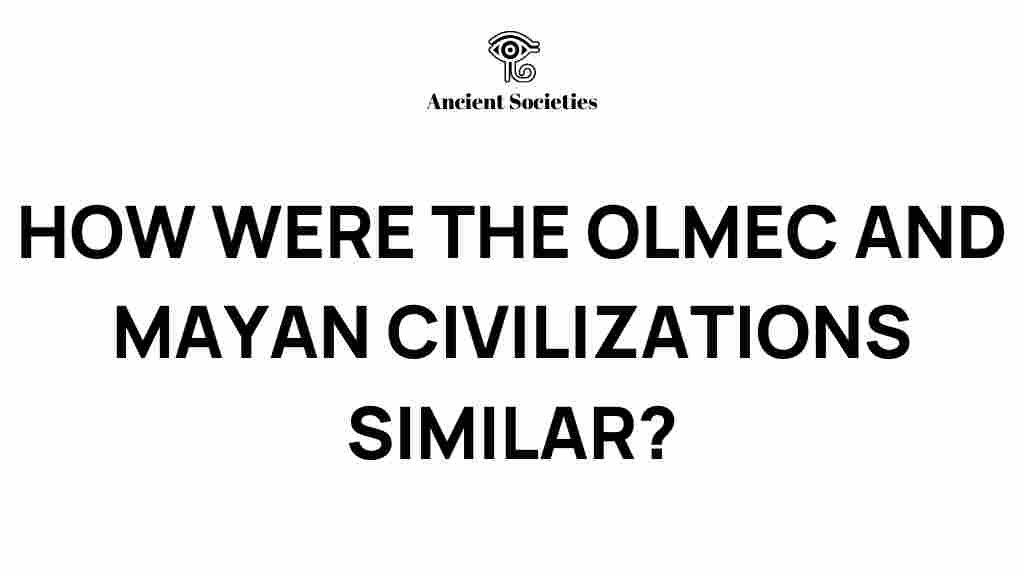Unveiling the Mysteries: Similarities Between Olmec and Mayan Civilizations
The ancient cultures of Mesoamerica have long fascinated historians and archaeologists alike, particularly the Olmec and Mayan civilizations. These societies, though distinct in their own right, share many similarities that provide insight into the broader narrative of Mesoamerican history. In this article, we will explore the similarities between the Olmec and Mayan civilizations, delving into their history, society, and cultural practices.
Introduction to Olmec and Mayan Civilizations
The Olmec civilization is often referred to as the “mother culture” of Mesoamerica, flourishing from around 1200 BCE to 400 BCE. Located primarily in the tropical lowlands of south-central Mexico, the Olmec are known for their impressive colossal heads and intricate jade carvings.
In contrast, the Mayan civilization emerged later, around 250 CE, and lasted until the Spanish conquest in the 16th century. Stretching across present-day Mexico, Guatemala, Belize, and Honduras, the Mayans are famed for their advanced writing system, impressive astronomical knowledge, and monumental architecture.
Despite their differences in time and space, there are notable similarities that connect these two ancient cultures. Understanding these connections enriches our appreciation for the complexities of Mesoamerican history.
Step-by-Step Exploration of Similarities
To uncover the profound connections between the Olmec and Mayan civilizations, we can analyze several key aspects:
1. Socio-Political Structures
- Chiefdoms: Both the Olmec and Mayan societies were organized into chiefdoms. This structure allowed for centralized authority and the ability to mobilize labor for large construction projects.
- Hierarchy: Social stratification was evident in both cultures, with a ruling elite, artisans, and commoners. This hierarchy influenced their political and economic systems.
2. Religion and Cosmology
- Polytheism: Both civilizations practiced polytheism, worshipping multiple gods associated with natural elements, agriculture, and fertility.
- Ritual Practices: Rituals and ceremonies played a vital role in their societies, including bloodletting and offerings, which were seen as essential for maintaining cosmic order.
3. Art and Iconography
- Artistic Styles: The Olmec and Mayan civilizations shared similar artistic styles, particularly in sculpture and ceramics. The Olmec colossal heads influenced later Mayan art.
- Symbolism: Both cultures used symbolic imagery in their art to convey religious and political messages, often depicting deities, animals, and mythological themes.
4. Writing and Communication
- Hieroglyphs: While the Olmec had a proto-writing system, the Mayans developed a fully-fledged hieroglyphic script. This evolution suggests a continuity of intellectual tradition.
- Record Keeping: Both civilizations utilized writing for record-keeping, although the extent and complexity varied.
5. Agricultural Practices
- Maize Cultivation: Maize was a staple crop for both the Olmec and Mayan civilizations, influencing their diets and economies.
- Terracing and Irrigation: Both cultures developed advanced agricultural techniques, including terracing and irrigation, to adapt to their environments.
Archaeological Discoveries and Their Impact
Archaeology plays a crucial role in unveiling the similarities between the Olmec and Mayan civilizations. Significant discoveries have been made that highlight their interconnectedness:
- Olmec Sites: Major archaeological sites like La Venta and San Lorenzo have revealed monumental architecture, intricate artifacts, and evidence of early urban planning.
- Mayan Sites: Sites such as Tikal and Copán showcase impressive pyramids, palaces, and inscriptions that reflect their advanced societal structures and cultural practices.
Recent excavations have also revealed trade routes that connected the Olmec and Mayan regions, suggesting cultural exchange and interaction. These findings further emphasize the similarities in their societies and highlight the dynamic nature of ancient Mesoamerican cultures.
Troubleshooting Common Misconceptions
As with any historical analysis, there are common misconceptions regarding the Olmec and Mayan civilizations. Here are a few to clarify:
- Misconception 1: The Olmec were not a “civilization.”
Correction: The Olmec are considered a civilization due to their complex society, monumental architecture, and influence on later cultures. - Misconception 2: The Mayans were the first civilization in Mesoamerica.
Correction: The Olmec civilization predates the Mayans and laid the groundwork for many cultural developments. - Misconception 3: The Mayans solely created their own culture without outside influence.
Correction: The Mayan civilization absorbed and adapted many aspects from earlier cultures, including the Olmec.
Conclusion: The Legacy of Olmec and Mayan Civilizations
The similarities between the Olmec and Mayan civilizations illuminate the rich tapestry of Mesoamerican history. Understanding these connections not only deepens our appreciation for these ancient cultures but also highlights the continuity and evolution of societal practices over time.
As archaeology continues to uncover new evidence, the narrative of the Olmec and Mayan civilizations will undoubtedly grow richer. The legacy of these ancient cultures serves as a reminder of the enduring human spirit and the complexities of societal development.
For those interested in delving deeper into the study of Mesoamerican archaeology, consider visiting resources such as Archaeology Magazine for the latest discoveries and insights.
Additionally, exploring local museums or archaeological sites can provide firsthand experience of the fascinating history of these civilizations. To learn more about the Olmec and Mayan civilizations, check out our comprehensive guide on ancient Mesoamerican cultures.
This article is in the category Archaeology and created by AncientSocieties Team
